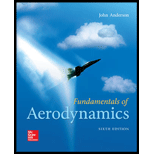
Consider the supersonic flow over a flat plate at an angle of attack, as sketched in Figure 9.35. As stated in Section 9.7, the flow direction downstream of the trailing edge of the plate, behind the trailing edge shock and expansion waves, is not precisely in the freestream direction. Why? Outline a method to calculate the strengths of the trailing edge shock and expansion waves, and the direction of the flow downstream of the trailing edge.
Want to see the full answer?
Check out a sample textbook solution
Chapter 9 Solutions
Fundamentals of Aerodynamics
Additional Engineering Textbook Solutions
Heat and Mass Transfer: Fundamentals and Applications
Vector Mechanics for Engineers: Dynamics
Thermodynamics: An Engineering Approach
Shigley's Mechanical Engineering Design (McGraw-Hill Series in Mechanical Engineering)
Engineering Mechanics: Statics
Machine Tool Practices (10th Edition)
- Consider a normal shock wave in a supersonic airstream where the pressure upstream of the shock is 1 atm. Calculate the loss of total pressure across the shock wave when the upstream Mach number is (a) M1 = 2.5, and (b) M1 = 4.5. Compare these two results and comment on their implicationarrow_forwardHow does the construction of a low speed and high-speed aircraft differ? What effects can be expected from supersonic flow on fuselage structure, discuss steps to minimise these effects.arrow_forwardA 20◦ half-angle wedge is mounted at 0◦ angle of attack in the testsection of a supersonic wind tunnel. When the tunnel is operating, thewave angle from the wedge leading edge is measured to be 41.8◦. Whatis the exit-to-throat area ratio of the tunnel nozzle?arrow_forward
- Explainwhat do you understand by the term “Compressibility Corrections” for thin airfoils in high subsonic flow and elaboratewhy it is important?arrow_forwardConsider a low-speed subsonic wind tunnel designed with a reservoir cross-sectional area of 2 m2 and a test-section cross-sectional area of 0.5 m2. The pressure in the test section is 1 atm.arrow_forwardWhat is the effect of heating the fluid on the flow velocity in subsonic Rayleigh flow? Answer the same questions for supersonic Rayleigh flow.arrow_forward
- A Pitot tube is inserted into an airflow where the static pressure is 1 atm. Calculate the flow Mach number when the Pitot tube measures (a) 1.276 atm, (b) 2.714 atm, (c) 12.06 atm.arrow_forwardSupersonic air at Ma1 = 2.0 and 230 kPa flows parallel to a flat wall that suddenly expands by ? = 10° . Ignoring any effects caused by the boundary layer along the wall, calculate downstream Mach number Ma2 and pressure P2.arrow_forwardAt subsonic speeds, how do the lift coefficient CL and drag coefficientCD for a wing vary with angle of attack α?arrow_forward
- An infinitely thin flat plate is operating at a given freestream Mach number of 2.4 where ambient pressure is 0.53 atm. Calculate Lift per unit span for an given angle of attack of 4 degrees using both shock-expansion theory and linearized theoryarrow_forwardEngineers call the supersonic combustion in a scramjetengine almost miraculous, “like lighting a match in a hurricane.”Figure C9.8 is a crude idealization of the engine.Air enters, burns fuel in the narrow section, then exits, all at supersonic speeds. There are no shock waves. Assume areasof 1 m2 at sections 1 and 4 and 0.2 m2 at sections 2 and3. Let the entrance conditions be Ma1 = 6, at 10,000 mstandard altitude. Assume isentropic fl ow from 1 to 2,frictionless heat transfer from 2 to 3 with Q = 500 kJ/kg,and isentropic fl ow from 3 to 4. Calculate the exit conditionsand the thrust produced.arrow_forwardConsider subsonic flow in a converging nozzle with fixed inlet conditions. What is the effect of dropping the back pressure to the critical pressure on (a) the exit velocity, (b) the exit pressure, and (c) the mass flow rate through the nozzle?arrow_forward
 Principles of Heat Transfer (Activate Learning wi...Mechanical EngineeringISBN:9781305387102Author:Kreith, Frank; Manglik, Raj M.Publisher:Cengage Learning
Principles of Heat Transfer (Activate Learning wi...Mechanical EngineeringISBN:9781305387102Author:Kreith, Frank; Manglik, Raj M.Publisher:Cengage Learning
